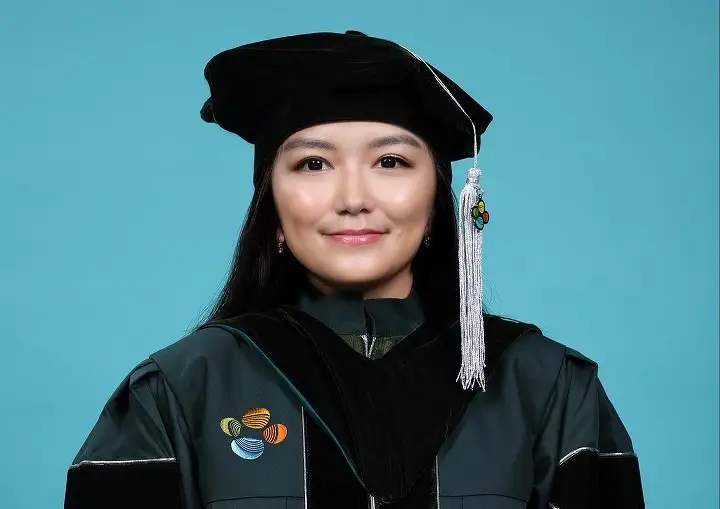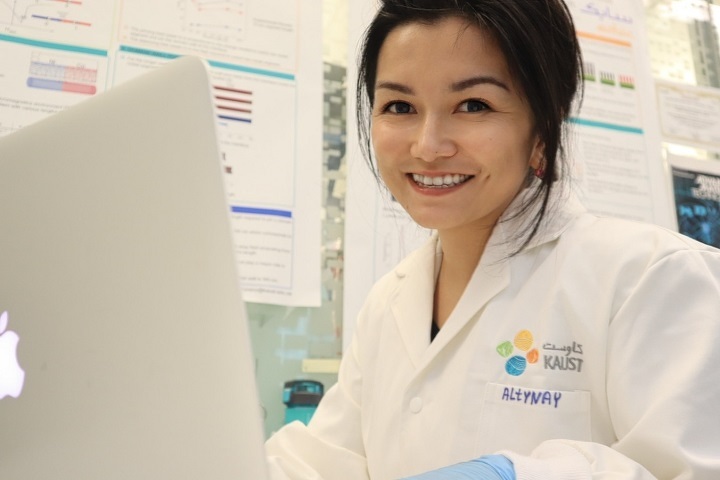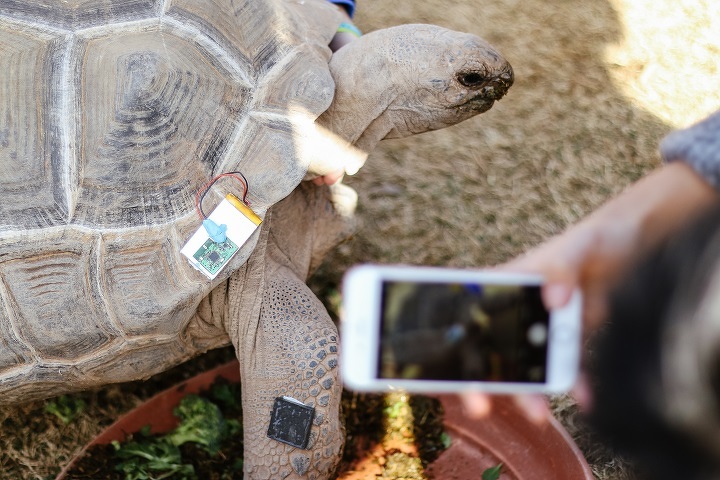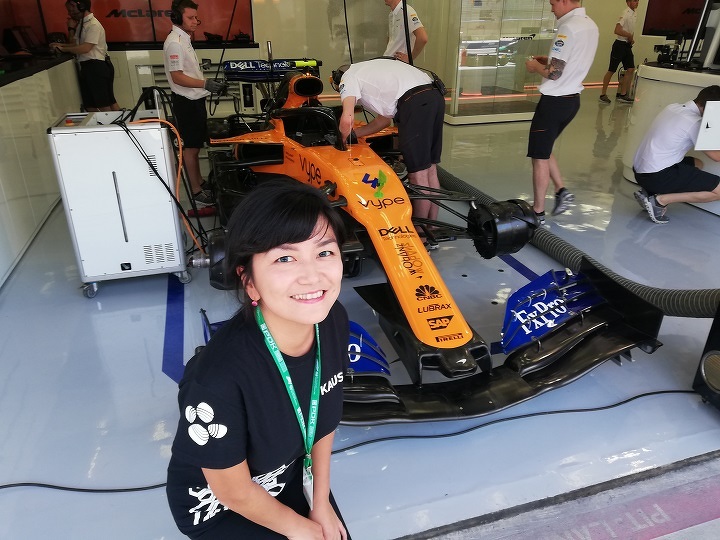
Young Kazakh Researcher Develops Electronic Skin and creates sensors for dolphins and racing cars
Imagine a Doctor of Technical Sciences in Belgium, who works with nanosensor technology, applies inventions in medicine, biology and automotive engineering, and cooperates with world-class renowned scientists. Who did you imagine reading the description? Clearly not a young woman from a small Kazakh city. But here she is — a 31-year-old Altynay Kaidarova from Aksu, Pavlodar region.
Altynay's father passed away when she was only two years old, the girl was raised by her mother and grandparents. Today, Altynay is an experienced scientist, yet she still feels the support of her family, which instilled not only respect for national traditions and her native language, but also a passion for science. They also taught her to set high goals.
Altynay received a good secondary education in one of the best gymnasiums for gifted children in Kazakhstan. Altynay studied there from the first grade. She excelled both in humanities and technical subjects. She was a student in a math class, but actively studied English. After graduating from school with a gold medal, she enrolled into the International Relations and Humanities Department of the Eurasian National University.
"I studied in-demand professions in 2010 and chose Electronic Communications. Then I applied to study at Nanyang Technological University (Singapore) under the Bolashak program. Soon I received the happy news that I got an international scholarship and without hesitation chose the opportunity to study at one of the best universities in the world," Altynay says.
The girl, who had never even been to Pavlodar (regional capital), had to travel halfway across the world - to the world of skyscrapers, the ocean and high technology.
"There were 12 students from Kazakhstan. Since only applicants with at least 12 years of school education were eligible for bachelor's degree, we enrolled in the Foundation Program for a year-long training course. This Program was supposed to prepare us for the university exam," our interlocutor recalls, "Despite the fact that we were all excellent students of various prestigious schools in Kazakhstan, we all failed this exam.
To clarify the situation, the then president of the Bolashak program, Sayasat Nurbek, came to Singapore. He met with the deputy dean of the admissions committee of Nanyang Technological University, and he explained that it was due to the outdated secondary education curriculum in Kazakhstan.
"He said that math is taught from the 70s syllabus. Over the past 40 years, math has advanced, albeit slowly; developed schools teach probability theory at an advanced level, while Kazakh schools teach it at an elementary level. As the deputy dean stressed, Nanyang University cannot invest in students who do not have the appropriate training for the first year of study," Altynai Kaidarova says.
As a result, Kazakhs students have been redirected to the universities of Toronto, London, Edinburgh, Bristol, etc. Altynay has chosen to enroll into the Electronic Communications Department at the University of Liverpool in the UK. And again she had to plunge into an unfamiliar culture and lifestyle — this time in Europe.
"Thanks to the scholarship, I had no problems with housing or tuition fees, which allowed me to fully focus on my studies. Responsibility before my family, their hope and faith in me were my main motivation. Three years flew by amid books, exams, coffee and friends.
Each exam was like a preparation for the battle with titans. The happiest time for me was the first hours after successfully passing the exam," Altynay smiles.
After returning to Kazakhstan with a bachelor's degree, Kaidarova worked as a researcher and teaching assistant at Nazarbayev University for about two years, then, on the advice of a colleague, she started grad school at the King Abdullah University of Science and Technology (KAUST) in Saudi Arabia.
"I believe that KAUST gave me the key to open the doors of the scientific world," the scientist says, naming points in favor of the Saudi university: strong global research activity, teachers are world scientists, access to modern technologies, comfortable conditions, a decent scholarship and medical insurance.

Kaidarova graduated from KAUST master's program in 2018 and became a Doctor of Technical Sciences in 2022.
"The next step is a postdoc! I recently received an offer for a postdoctoral job at KU Leuven in Belgium," the girl says happily.
KU Leuven is the Catholic University of Leuven, one of the most famous and prestigious in Europe. The word "Catholic" in the title is rather a tribute to tradition. The university has nothing to do with the church, on the contrary, it is considered the most innovative European research university.
"Currently, my research is focused on the development of technologies for wearable electronics, flexible and elastic nanosensors, as well as devices for collecting the energy necessary for their work. This technology monitors the health of people and animals, analyzes the parameters of the Red and Caspian Seas, and controls the operation of the McLaren Formula 1 racing car," Altynai lists, probably thinking that everyone understands this as well as she does.

Naturally, we had to ask her to explain it "for dummies". The nanosensors in question are made of graphene, a unique material consisting of just one layer of carbon atoms. Graphene is stronger than steel, has high electrical conductivity, does not corrode and is compatible with living organisms.
"I want to use graphene to create sensors, such as temperature, pressure, conductivity, salinity, velocity sensors, as well as water flow sensors and magnetic sensors. One of the main obstacles to the widespread distribution of graphene is the high cost of its production due to complex technological processes and expensive equipment.
During my doctoral studies, I worked on developing more economical and sustainable methods of graphene production to make it more affordable and accelerate its integration into various industries," Altynay switches to the language of science, "I used a one-step manufacturing process called laser-induced graphene. This method allowed me to obtain graphene directly on the surface of elastic polymers using a laser, significantly reducing the cost (up to 50 cents per sensor) and simplifying the production. This has opened up new possibilities for the use of graphene in various fields, from marine life monitoring to new racing cars.
How does graphene become a sensor? Interacting with different substances or getting into different conditions, it changes its electrical properties. The electronic components connected to the sensor then process and amplify these changes, converting them into digital signals that can be analyzed.
How do you use it in real life? Take, for example, Kaidarova's work with Formula 1 racing cars. Today, these cars are equipped with hundreds of sensors that transmit gigabytes of data on speed, airflow, engine temperature, braking, exhaust and much more. However, many sensors weigh down supercars. Here is how Altynay's development, made under the guidance of her supervisor Professor Jurgen Kozel, came in handy — graphene sensors are ultralight and are resistant to overloads during the race.

These properties also proved necessary for nanosensors on marine animals — to study their behavior and habitat.
"Graphene has a high biocompatibility, which makes it suitable for use in medical and biological systems. Now we are working on a flexible electronic skin that can be used to measure blood pressure, temperature and oxygen levels in a person's blood in real time. This will help in diagnosis and medical care," the scientists says, "The skin is the largest and most complex organ of our body: it is flexible, stretchable, self-healing and biodegradable. I am working on a new subject — electronic skin, similar to human skin, for prosthetics and robotics
"Electronic skin will allow people with artificial limbs to feel touch, to distinguish between soft and hard, to detect sharp or scalding hot objects," Altynay shares.
"Our modern electronic devices are very rigid, fragile and bulky. However, if we can make them look like skin, it will completely change the way people engage with electronics.
Our skin serves as a natural protective barrier from the environment, but it can also become an interface between a person and devices," the young researcher reveals fantastic prospects.
Now Altynay Kaidarova is busy developing separate "building blocks" of electronic skin, such as circuits, energy collectors and energy storage units.
Altynay admitted that commercial use of electronic skin is in the distant future, but her current work can revolutionize medicine and dramatically improve the quality of life of many people.
A series of interviews with our compatriots who have achieved outstanding success abroad. Implemented jointly with Forbes Kazakhstan